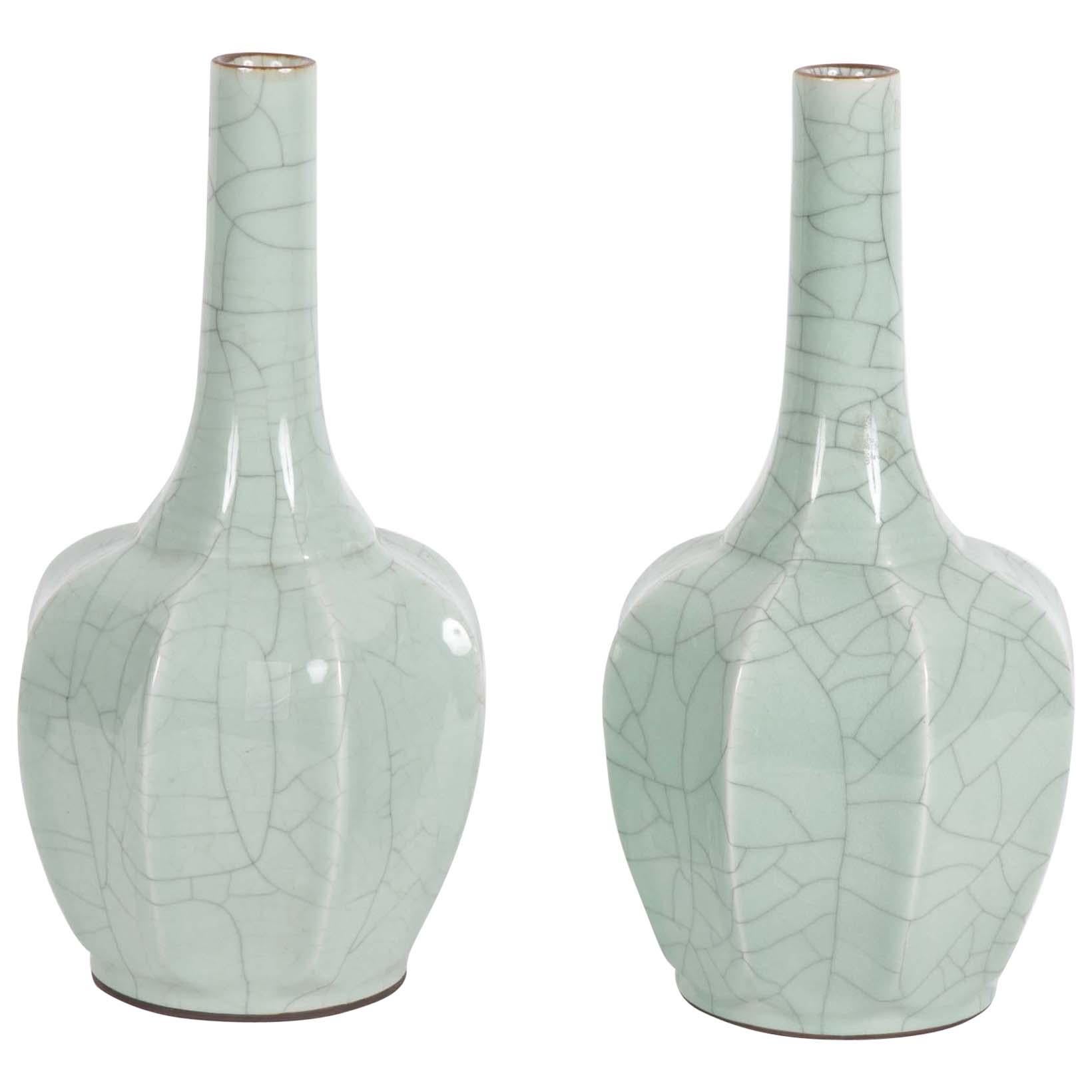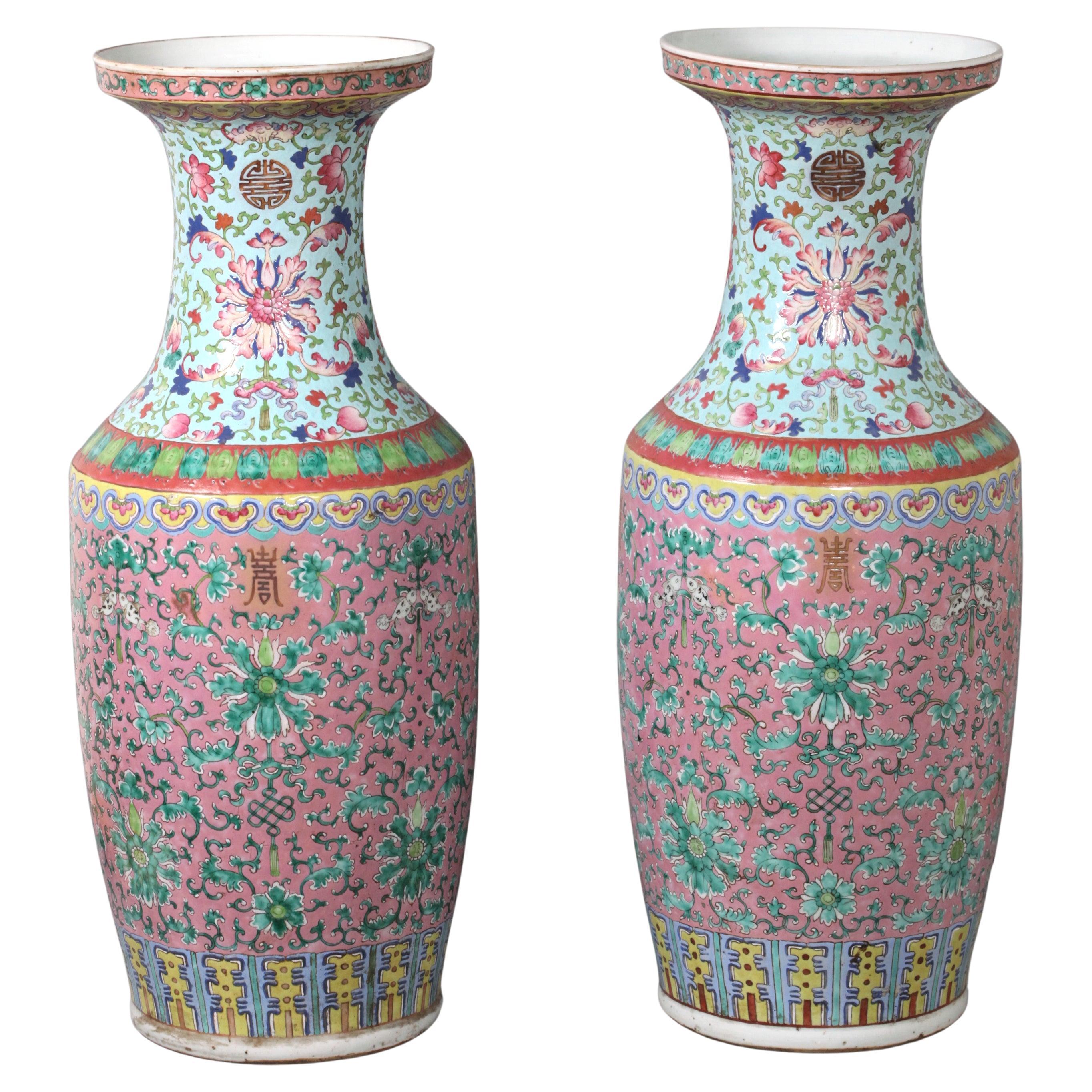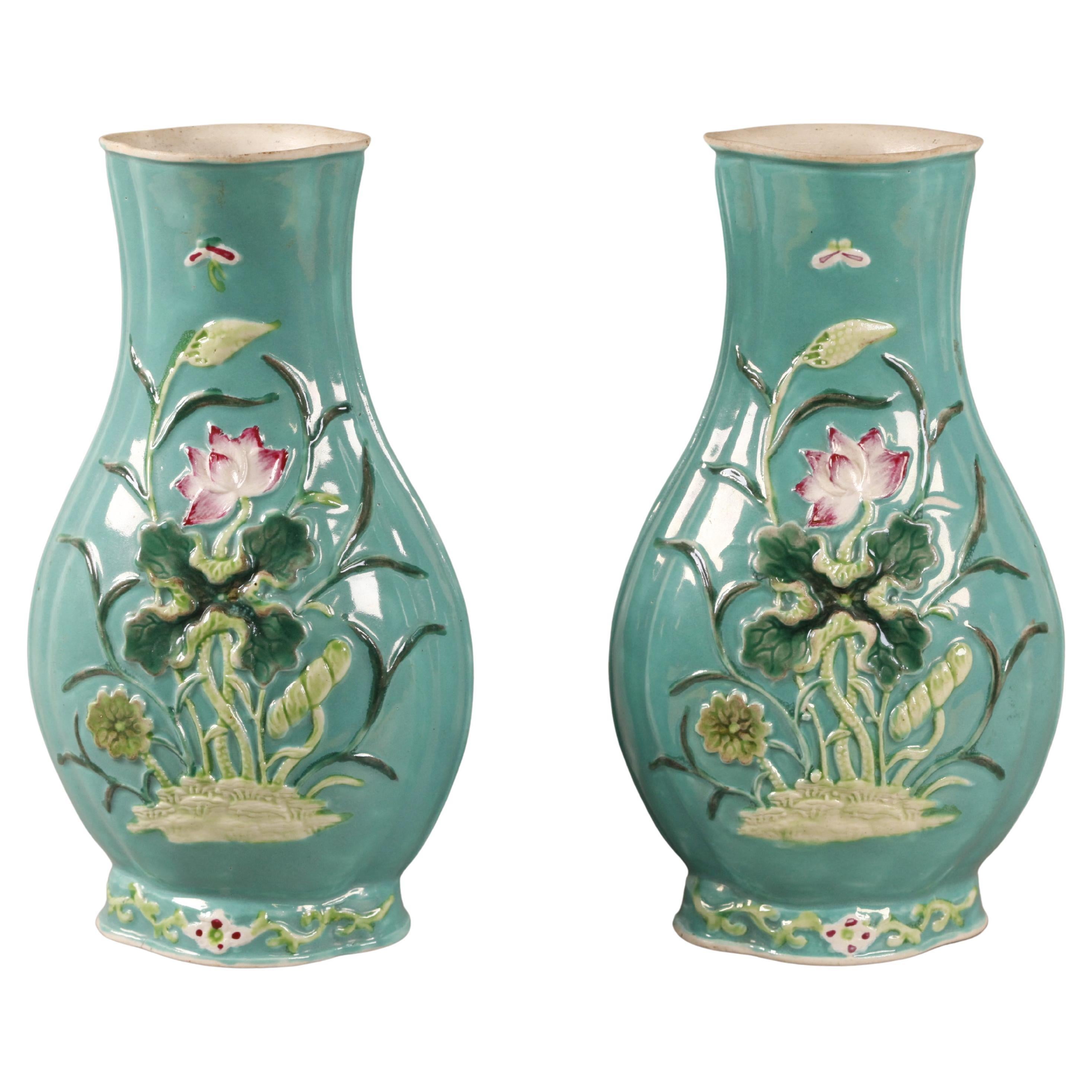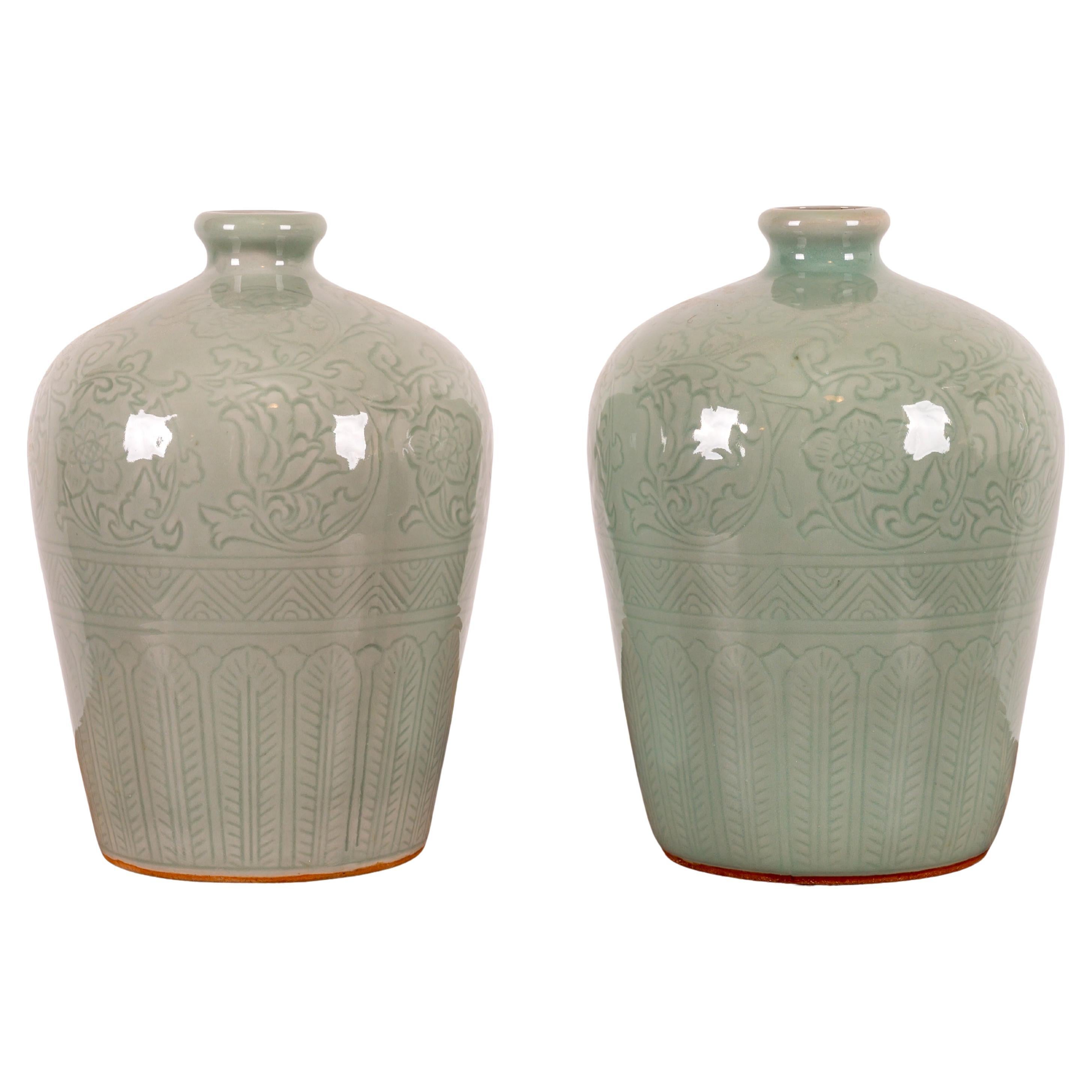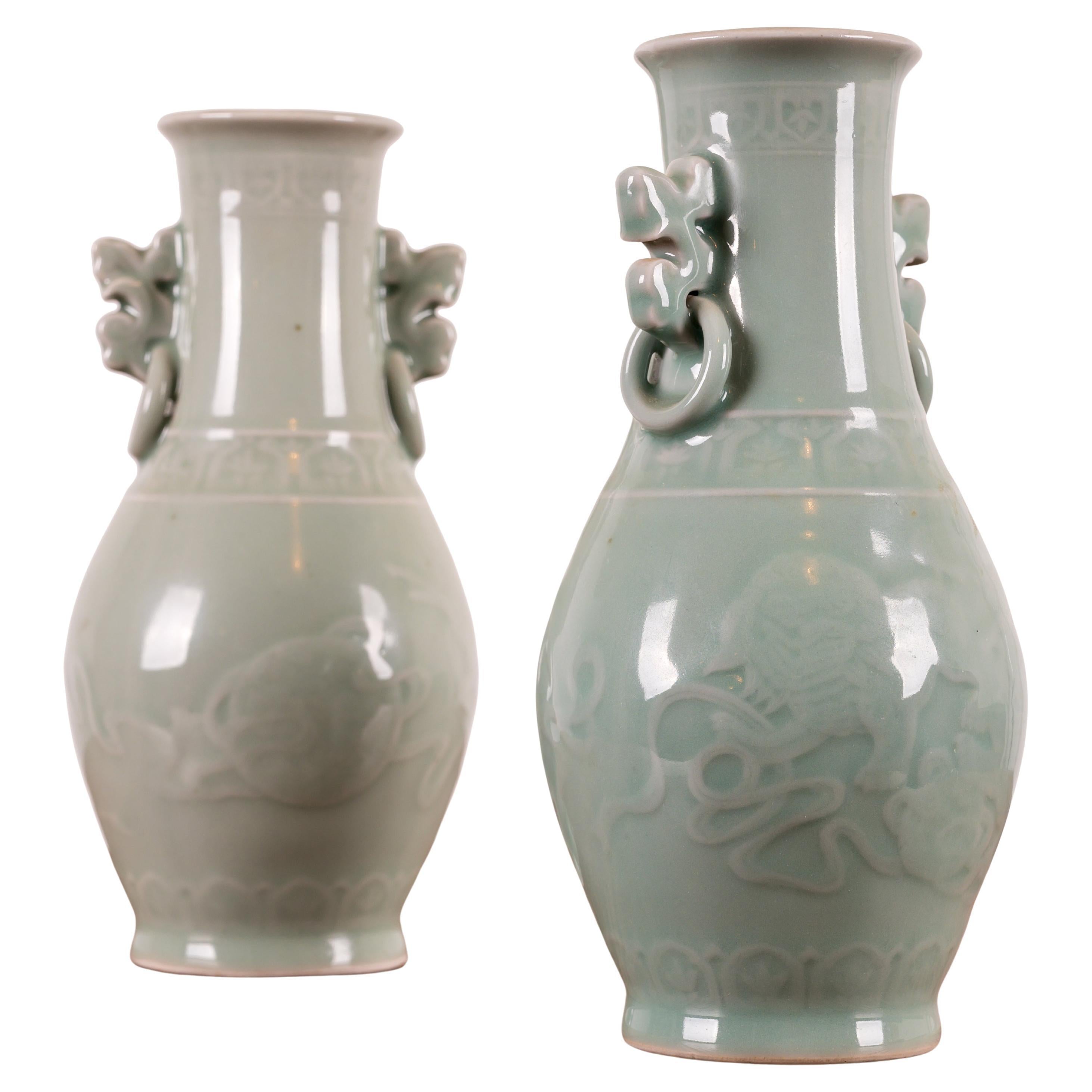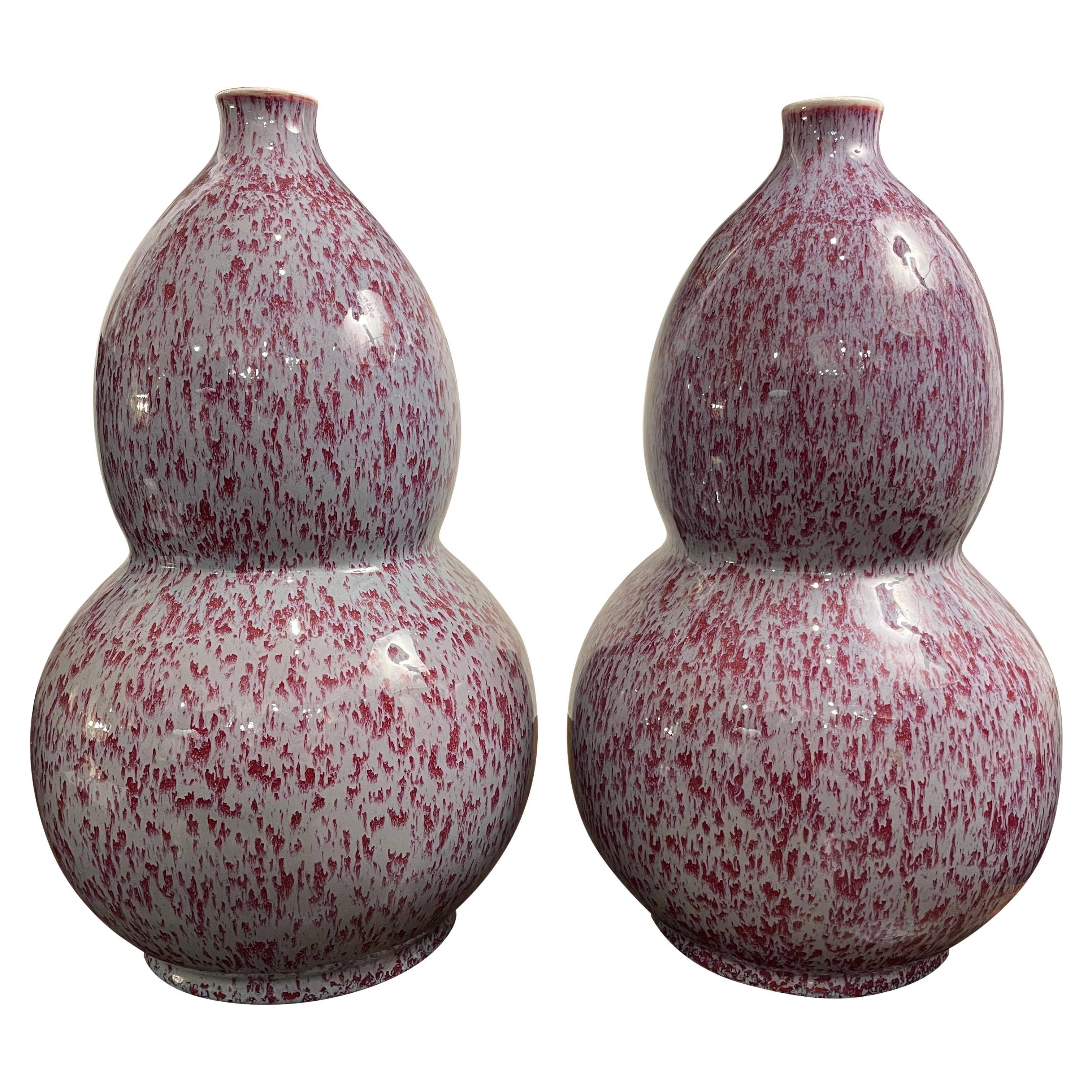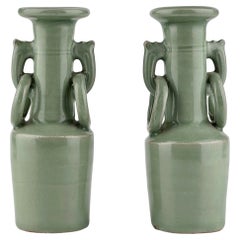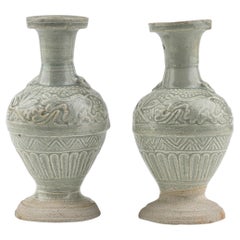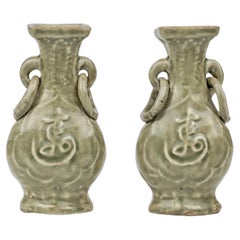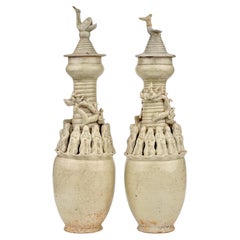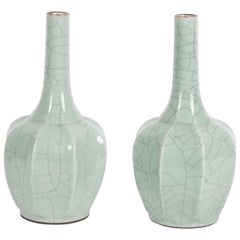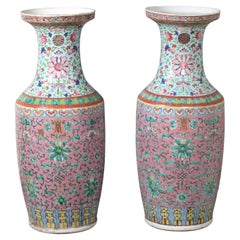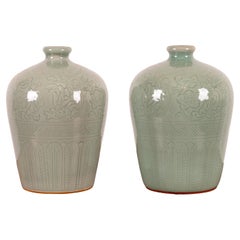Items Similar to Pair of Qingbai Vases, Song-Yuan Dynasty
Want more images or videos?
Request additional images or videos from the seller
1 of 13
Pair of Qingbai Vases, Song-Yuan Dynasty
$3,970per set
£3,015.54per set
€3,474.92per set
CA$5,590.74per set
A$6,198.17per set
CHF 3,257.38per set
MX$75,855.38per set
NOK 40,681.34per set
SEK 38,183.51per set
DKK 25,938.15per set
About the Item
This pair of Qingbai vases features a soft bluish-green glaze with elegant, fluted bodies and wide, flared rims. The vases are hand-crafted, with subtle differences that highlight their artisanal nature. The base is unglazed, and brownish-black where exposed. The surface also reveals signs of age.
Period : Southern Song-Yuan Dynasty(12th-14th century)
Type : Vase
Medium : Qingbai ware
Provenance : Acquired in late 1990s from Hongkong
Reference :
1) Art Gallery NSW - Accession number EC71.1962
(Type : related)
2) British Museum - Museum Number PDF,A.496
(Type : related)
* Qingbai Ware
Qingbai ware, which translates to "blue-white ware," is a type of Chinese porcelain that was made at the Jingdezhen and other kilns in the porcelain-producing regions of China, primarily during the Song dynasty (960–1279) and continuing into the Yuan dynasty (1271–1368). It is known for its translucent quality and the pale blue-green glaze that characterizes most of its pieces.
The qingbai glaze was achieved using a small amount of iron in a reduction-fired atmosphere, which produced the subtle blue-green tint. The body of qingbai ware is typically made of a fine, white porcelain that is often referred to as 'artificial jade' due to its resemblance to the esteemed stone. The thinness of the body and the high firing temperatures used contributed to the translucent quality of the finished product.
Qingbai ware includes a range of items such as bowls, cups, vases, and ewers. The designs are usually simple and elegant, with an emphasis on the graceful lines and form of the objects. Decorative motifs, when present, are often incised, carved, or molded in relief and can include floral patterns, dragons, phoenixes, and other symbolic elements drawn from Chinese culture.
Over time, the technology and techniques used to produce qingbai ware evolved, leading to innovations in glaze and decoration that would influence later types of Chinese porcelain. Despite these changes, qingbai ware remains a distinguished example of the potters' art in Song and Yuan China, reflecting the refined aesthetic and cultural values of the period.
- Dimensions:Height: 6.89 in (17.5 cm)Diameter: 2.17 in (5.5 cm)
- Sold As:Set of 2
- Materials and Techniques:Porcelain,Glazed
- Place of Origin:
- Period:
- Date of Manufacture:12th-14th century
- Condition:Minor fading.
- Seller Location:seoul, KR
- Reference Number:1stDibs: LU9577241192062
About the Seller
4.8
Gold Seller
Premium sellers maintaining a 4.3+ rating and 24-hour response times
Established in 1999
1stDibs seller since 2023
39 sales on 1stDibs
Typical response time: 4 hours
- ShippingRetrieving quote...Shipping from: seoul, Korea South
- Return Policy
Authenticity Guarantee
In the unlikely event there’s an issue with an item’s authenticity, contact us within 1 year for a full refund. DetailsMoney-Back Guarantee
If your item is not as described, is damaged in transit, or does not arrive, contact us within 7 days for a full refund. Details24-Hour Cancellation
You have a 24-hour grace period in which to reconsider your purchase, with no questions asked.Vetted Professional Sellers
Our world-class sellers must adhere to strict standards for service and quality, maintaining the integrity of our listings.Price-Match Guarantee
If you find that a seller listed the same item for a lower price elsewhere, we’ll match it.Trusted Global Delivery
Our best-in-class carrier network provides specialized shipping options worldwide, including custom delivery.More From This Seller
View AllPair of Celadon Vases with Double Handles, Song-Yuan Dynasty
Located in seoul, KR
These tall-necked vases feature gently flared rims and double dragon-form handles on the shoulders, each suspending a large, free-moving ring. The surfaces are covered with a lustrou...
Category
Antique 15th Century and Earlier East Asian Antiquities
Materials
Celadon
Two white ware vases with flower design, Yuan Dynasty, 14th century
Located in seoul, KR
Porcelain with transparent pale-green (qingbai-type) glaze with flower, leaves and lotus design of typical yuan dynasty.
Period : Yuan Dynasty(1271-1368)
Type : Baluster vase
Medium...
Category
Antique 15th Century and Earlier Hong Kong Antiquities
Materials
Ceramic, Porcelain
Two Set of Molded Longquan Celadon 'Fu Shou' Vases, Ming Dynasty
Located in seoul, KR
One side of the vase showcases a panel with the Shou character at its center, symbolizing longevity, while the opposite side displays the Fu character, signifying luck. The neck of the vase is adorned with leaves.
Period: Yuan-Ming Dynasty (1271-1644)
Region: Longquan, China
Medium: Celadon
Type: Ewer
Provenance : Acquired in late 1990s from Hongkong
Reference
1) British Museum - Museum number 1931,1118.5
(Type : Closely related)
2) Christies NEW YORK 24–25 MAR 2022 - Important Chinese Ceramics and Works of Art - Lot 1105
(Price realised : 9,450 USD / Type : Related)
3) Sotheby's New York 19 March 2024 - Chinese Art - Lot 172
(Price range : 15,000 USD - 20,000 USD / Type : Related)
* Ming Dynasty Longquan Celadon
Longquan celadon from the Ming Dynasty typically exhibits a more robust and heavier stoneware body compared to its Song Dynasty predecessors. The Ming era saw an evolution in celadon glaze, achieving a wider spectrum of green hues, from olive to bluish-greens. Ming celadons...
Category
Antique 15th Century and Earlier Hong Kong Ming Antiquities
Materials
Celadon
Pair of Qingbai Funerary Vases with Daoist figures, Southern Song-Yuan Dynasty
Located in seoul, KR
A pair of large Qingbai jars from the Song or Yuan Dynasty, designed for tomb offerings, featuring tall proportions with short bodies and extended necks. These Mingqi jars, typically...
Category
Antique 15th Century and Earlier Hong Kong Vases
Materials
Ceramic, Porcelain
Pair of Small Jarlet with arabesque design, Late Ming Era(16-17th century)
Located in seoul, KR
Pair of jarlet from the late Ming dynasty cargo. An identical piece is included on page 145 of the Bin Thuan catalog titled 'The Age of Discovery: Asian Cera...
Category
Antique 16th Century Vietnamese Ming Antiquities
Materials
Ceramic, Porcelain
Two Annamese Small Yuhuchunping, 15th century, Le Dynasty
Located in seoul, KR
These 15th-century Annamese ceramics from Le dynasty, are notable for their rarity and refined design. The Yuhuchunping vases, with their elegant pear-shaped bodies and delicate blue...
Category
Antique 15th Century and Earlier Vietnamese Ming Antiquities
Materials
Ceramic, Stoneware
You May Also Like
Pair of 19th Century Chinese Guan Type Vases
Located in Stamford, CT
Pair of 19th century Chinese Guan type vases in bottle form with gentle broad fluting.
Category
Antique 19th Century Chinese Qing Vases
Materials
Porcelain
Pair of Chinese Porcelain Vases
Located in New York, NY
decorated with pastel colors, floral motif
Category
Early 20th Century Chinese Antiquities
Materials
Porcelain
$9,000 / set
pair of Chinese porcelain vases, Republican Period
Located in New York, NY
floral motif in relief on turquoise ground
Category
Early 20th Century Chinese Antiquities
Materials
Porcelain
A Pair of Chinese Celadon Vases
Located in Savannah, GA
A pair of Chinese celadon vases, 20th century.
6 ½ inches wide by 8 ¾ inches tall
Category
20th Century Chinese Ceramics
Materials
Celadon
$880 / set
A Pair of Chinese Celadon Vases
Located in Savannah, GA
A pair of Chinese celadon vases, 20th century.
4 inches wide by 8 inches tall
Category
20th Century Chinese Ceramics
Materials
Celadon
$480 / set
A Pair of Chinese Double Groud Vases, Late 20th Century
Located in ARMADALE, VIC
A Pair of Chinese Double Groud Vases, Late 20th Century
Home Decor, Interior Design and Collectibles.
Provenance: Private Australian Collection.
Dimension:
Height: 35cm
Diameter: 2...
Category
Late 20th Century Chinese Qing Ceramics
Materials
Porcelain
More Ways To Browse
Song Dynasty
Chinese Song Dynasty
Song Dynasty Furniture
Antique Iron Glaze
Antique And Artisan Gallery
Song Porcelain
Jade Vases Antique
Song Dynasty Vase
Thin Porcelain Chinese
Song Dynasty Porcelain
Green Dragon Vase
14th Century China
Chinese 14th Century
Chinese Dragon And Phoenix
Chinese Jade Vase
Porcelain Flute Vase
Phoenix Chinese Vase
Iron Chinese Vase
